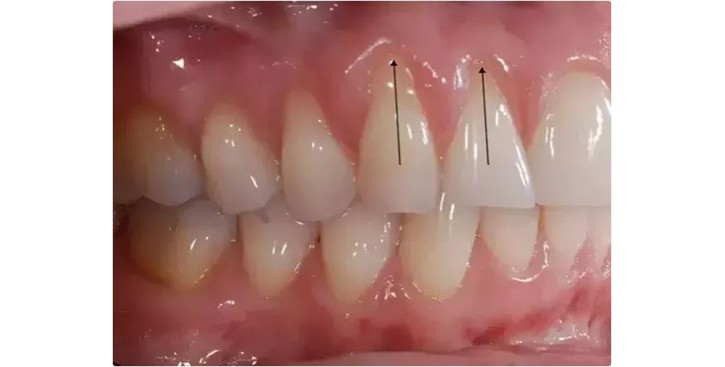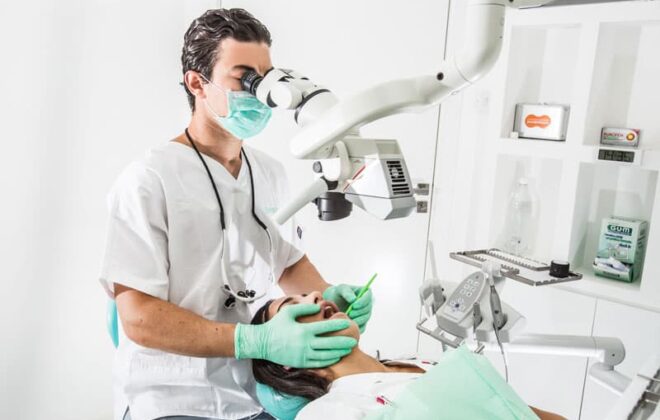Symptoms and treatment of an exposed tooth root
The tooth root sits below the gumline and helps anchor the tooth in the jawbone. An exposed root can indicate damage to the gums or teeth.
When a tooth root is no longer concealed by the gums, this can trigger sensitivity and pain. Without treatment, it may lead to infection and other complications.
This article describes the causes and symptoms of an exposed tooth root, as well as various treatments and signs that a trip to a dentist is necessary.
What is an exposed tooth root?
Only about half of a tooth is visible in the mouth. The rest sits below the gumline and anchors the tooth in the jawbone. This concealed part of the tooth is called the “root.”
All teeth have at least one root, but some have two or three. Each root resembles a prong. Like the rest of the tooth, the root contains nerves and sensitive tissue. When the root is exposed to the air, it can become damaged and cause intense pain.
Symptoms
Many dental issues can cause tooth pain and sensitivity. If the teeth look thinner near the gums, or if one or more prong-like projections are visible, the issue may be an exposed tooth root.
An exposed root may not be visible, however, depending on the location of the affected tooth.
In a tooth located in the front of the mouth, a person may be able to see some or all of an exposed root if:
- Damage to the gums exposes the deeper structures of the tooth.
- The top of the tooth has broken off, leaving the root visible.
- The tooth is beginning to rotate, loosen, or fall out.
A person with an exposed root may also experience:
- pain when brushing the teeth
- bleeding gums
- changes to the shape of the gums or teeth
Causes
A tooth root may become exposed as a result of a sudden injury, such as a blow to the mouth. The exposure may instead happen gradually, due to tooth decay or gum disease. Below, we explore these issues in more detail:
Injury to the mouth
Injuries to the mouth can break or move the teeth, causing the roots to become visible. For example, a blow to the face may cause a tooth to shift in the gums, exposing its root.
Gum recession
This refers to the gums pulling away from the teeth or drawing downward, exposing parts of the tooth that would normally be concealed. Severe gum recession may expose the roots of the teeth.
Gum recession may also cause the teeth to become more sensitive or painful.
Several factors increase the risk of receding gums, including:
- gum disease
- brushing too hard
- aging
- smoking
- having badly fitting dentures
- damage from surgery or injury
- genetic predispositions
Tooth decay
Untreated tooth decay can lead to exposed tooth roots. In most cases, this happens slowly over time.
As decay eats through the protective enamel coating of a tooth, the person may have increased sensitivity or pain. Eventually, the root may become visible, especially if the decay is so advanced that the tooth breaks.
Poorly aligned teeth
Having misaligned or crowded teeth can increase the risk of gum disease and tooth decay, both of which can expose the roots of teeth.
If the teeth are severely misaligned or crowded, they may also rotate or shift, which can cause their roots to emerge from below the gumline.
Other factors
Less commonly, a tooth’s root becomes exposed due to:
- a lost filling
- medications that damage the teeth or their roots
- complications of oral surgery, such as if the surgeon removes most of the tooth but leaves a part of the root beneath the gumline
- genetic disorders and anomalies, such as conditions that cause very short tooth roots
Exposed vs. nonexposed roots
Only the top portions of healthy teeth are visible. The gums should look even across all teeth, with no significant differences in shape or thickness.
If a root is exposed due to gum recession, the gums may look uneven — with some teeth having less gum tissue than others. There may also seem to be gaps or pockets between the teeth and gums.
Treatments
The most effective approach depends on the cause of the tooth root exposure:
- Decay: The dentist may remove the decayed area of the tooth and insert a filling. If the decay is severe, more intensive treatment, such as a root canal, a crown, or a tooth extraction may be necessary.
- Gum recession: The dentist may perform scaling and root planing procedures to remove plaque from beneath the gumline. In some cases, the person may need surgery to graft healthy gum tissue onto areas of severe recession.
- Trauma: This may require emergency treatment. Depending on the injury, the treatment may concern the tooth as well as the jaw or other surrounding structures.
- Misaligned teeth: Orthodontic treatments such as braces can help align the teeth. A person with severe misalignment or decay may need surgery.
When to see a dentist
If a person notices an exposed tooth root, they should see a dentist as soon as possible.
However, an exposed root is not always visible, especially if the tooth is at the back of the mouth or crowded by other teeth. For this reason, a person should also see a dentist if they experience any of the following symptoms:
- sensitivity to cold or heat
- pain when brushing the teeth
- gums that bleed frequently
- changes to the shape of the teeth or gums
Seek emergency dental care if any of the following occur:
- breaks in a tooth
- a serious blow to the mouth
- severe pain that does not respond to analgesic medication
- tooth pain accompanied by a fever
- any other indications of an infection or abscess
Summary
An exposed tooth root can cause sensitivity or pain, which can be intense. There are many causes, including tooth decay, gum recession, trauma, and misaligned teeth.
Anyone who notices an exposed tooth root or experiences symptoms should see a dentist as soon as possible. Prompt treatment reduces the risk of complications, as well as the need for more extensive medical treatments.
Author: Zawn Villines
Article originally appeared at: https://www.medicalnewstoday.com/



